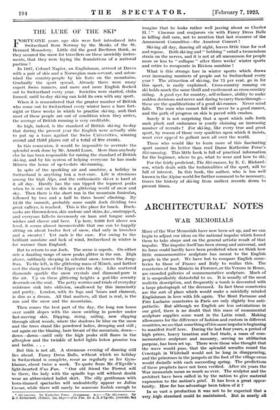ARCHITECTURAL' NOTES
WAR MEMORIALS
Mosr of the War Memorials have now been set up, and we can begin to adjust our ideas on the national impulse which forced them to take shape and on the general artistic result of that impulse. The impulse itself has-been strong and universal, and its force could hardly have been predicted when we think how little commemorative sculpture has meant to the English people in the past. We have but to compare English ceme- teries to those of France and Italy to realize this. The cemeteries of San Miniato in Florence, or the Verano in Rome, are crowded galleries of commemorative sculpture. Much of it is unspeakably distasteful to us. It is usually -of the most realistic description, and frequently a-tomb is decorated with a large photograph of the deceased. In fact these cemeteries are the sort -of place which would make a suicidally minded Englishman in love with life _again. The Mont Parnasse and Pere Lachaise cemeteries in Paris are only slightly less anti- pathetic. But although we English are less -ostentatious in our grief, there is no doubt that this mass of monumental sculpture supplies some want in the Latin mind. Making allowances for the difference of fashion and custom in different countries, we see that something ofthis same impulse is beginning to manifest itself here. During the last fouryears, a period of high prices, heavy taxation and bad trade, a mass of com- memorative sculpture and masonry, serving no utilitarian purpose, has been set-up. There were those who thought that the wave would pass, that the splendid wreaths round the Cenotaph in Whitehall would not be long in disappearing, and the primroses in the jampots at the foot of the village cross would dwindle with each succeeding spring. The predictions of these prophets have not been verified. After six years the War memorials-mean as-much as 'ever. The sculptor and the architect have been celled in by the nation to give material expression to the natiot's grief. It has been a great oppor- tunity. How far has advantage been taken of it ?
In so vast a production it was -not to be expected that a very high standard could be maintained. But in nearly all
conspicuous examples an attempt has been made to get the best. It is sad to think how many village communities have held that a granite cross of painful ugliness and aridity of design, to be obtained in various sizes from the large depart- mental stores, was an adequate commemoration for young lives sacrificed in pain and horror. But probably the majority of the War memorials, judged from purely aesthetic standards, are better than they would have been in the commercialized decades of the mid-Victorian period, though less good than those which a similar need would have produced in Stuart or Georgian times. A few memorials of extraordinary merit have been erected, and if future ages are kind enough to judge ,us by our best we need not fear their verdict.
Certain broad generalizations emerge from even a super- 'ficial study of the War memorials already put up. The only satisfactory materials are bronze and stone, preferably Portland. Marble weathers badly in England, and polished granite does not weather at all. Both are, therefore, to be avoided. Almost all the successful large memorials are cenotaphs or obelisks, the former nearly always based on the Whitehall prototype. The obelisk has a satisfying and monu- mental simplicity, and nothing has-yet been found which quite takes its place for an open site. But the scale must be large ; 'small obelisks do not come off." All the experience of the ;past shows that, unless a definite personage is being com- memorated and a portrait is desired, the sculpture, if any, ishould be subordinated to the architectural design. The present War has not hitherto produced any monuments, in 'which sculpture plays a predominant part, to be compared with the Guards Crimean Memorial in Waterloo Place. Celtic 'crosses (except perhaps in Cornwall and the Highlands) look :very foreign and unsuitable in the tame and tender English 3andscape. Crosses in general make bad memorials owing to their inherent fragility, but the most satisfactory ones are based on the few English mediaeval examples which have ,survived.
. It is very much to be hoped that a complete-" Corpus" of till the English War memorials may be made in the course of the next ten years.











































 Previous page
Previous page